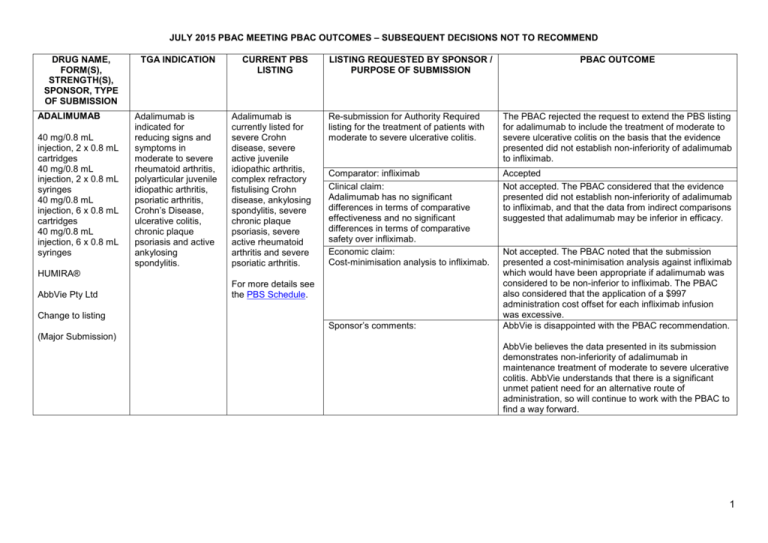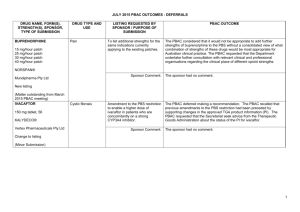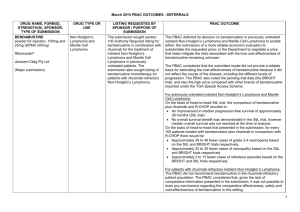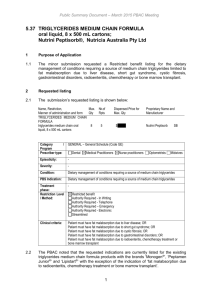July 2015 - Subsequent decisions Not to Recommend (Word
advertisement

JULY 2015 PBAC MEETING PBAC OUTCOMES – SUBSEQUENT DECISIONS NOT TO RECOMMEND DRUG NAME, FORM(S), STRENGTH(S), SPONSOR, TYPE OF SUBMISSION ADALIMUMAB 40 mg/0.8 mL injection, 2 x 0.8 mL cartridges 40 mg/0.8 mL injection, 2 x 0.8 mL syringes 40 mg/0.8 mL injection, 6 x 0.8 mL cartridges 40 mg/0.8 mL injection, 6 x 0.8 mL syringes TGA INDICATION Adalimumab is indicated for reducing signs and symptoms in moderate to severe rheumatoid arthritis, polyarticular juvenile idiopathic arthritis, psoriatic arthritis, Crohn’s Disease, ulcerative colitis, chronic plaque psoriasis and active ankylosing spondylitis. CURRENT PBS LISTING Adalimumab is currently listed for severe Crohn disease, severe active juvenile idiopathic arthritis, complex refractory fistulising Crohn disease, ankylosing spondylitis, severe chronic plaque psoriasis, severe active rheumatoid arthritis and severe psoriatic arthritis. LISTING REQUESTED BY SPONSOR / PURPOSE OF SUBMISSION Re-submission for Authority Required listing for the treatment of patients with moderate to severe ulcerative colitis. The PBAC rejected the request to extend the PBS listing for adalimumab to include the treatment of moderate to severe ulcerative colitis on the basis that the evidence presented did not establish non-inferiority of adalimumab to infliximab. Comparator: infliximab Clinical claim: Adalimumab has no significant differences in terms of comparative effectiveness and no significant differences in terms of comparative safety over infliximab. Economic claim: Cost-minimisation analysis to infliximab. Accepted Not accepted. The PBAC considered that the evidence presented did not establish non-inferiority of adalimumab to infliximab, and that the data from indirect comparisons suggested that adalimumab may be inferior in efficacy. HUMIRA® AbbVie Pty Ltd Change to listing PBAC OUTCOME For more details see the PBS Schedule. Sponsor’s comments: Not accepted. The PBAC noted that the submission presented a cost-minimisation analysis against infliximab which would have been appropriate if adalimumab was considered to be non-inferior to infliximab. The PBAC also considered that the application of a $997 administration cost offset for each infliximab infusion was excessive. AbbVie is disappointed with the PBAC recommendation. (Major Submission) AbbVie believes the data presented in its submission demonstrates non-inferiority of adalimumab in maintenance treatment of moderate to severe ulcerative colitis. AbbVie understands that there is a significant unmet patient need for an alternative route of administration, so will continue to work with the PBAC to find a way forward. 1 NOVEMBER 2014 PBAC OUTCOMES – SUBSEQUENT DECISIONS NOT TO RECOMMEND DRUG NAME, FORM(S), STRENGTH(S), SPONSOR, TYPE OF SUBMISSION AFATINIB DIMALEATE 20 mg tablet, 28 30 mg tablet, 28 40 mg tablet, 28 50 mg tablet, 28 GIOTRIF® Boehringer Ingelheim Pty Limited TGA INDICATION Monotherapy for patients with advanced or metastatic non-squamous type non-small cell lung cancer (NSCLC), either as a first line therapy or after failure of cytotoxic chemotherapy. CURRENT PBS LISTING Not currently PBS listed LISTING REQUESTED BY SPONSOR / PURPOSE OF SUBMISSION PBAC OUTCOME Re-submission for Authority Required listing for the treatment of patients with stage IIIB (locally advanced) or stage IV (metastatic) NSCLC with epidermal growth factor receptor (EGFR) mutation(s). The PBAC did not recommend the more restricted listing of afatinib dimaleate in patients with locally advanced or metastatic NSCLC characterised by exon 19 deletion mutations of the EGFR gene. Comparator: Erlotinib and gefitinib Clinical claim: The re-submission described afatinib as having improved clinical outcomes compared with gefitinib and erlotinib in patients with exon 19 deletion EGFR mutations. Accepted Not accepted: The PBAC considered that the data provided in the submission did not provide sufficient evidence to demonstrate that afatinib is associated with improved clinical outcomes for the EGFR exon 19 deletion subgroup, in comparison with gefitinib and with erlotinib. Economic claim: Cost-effectiveness of afatinib compared with erlotinib or gefitinib. Not accepted: The PBAC considered that the cost-effectiveness approach used for the economic evaluation could not confidently estimate the quantified differences in efficacy and safety that were proposed by the submission, noting that: the model relied on the point estimates of hazard ratios for progression free survival and overall survival obtained from indirect comparisons of non-exchangeable trials; and the majority of the results were not statistically significant and there were wide confidence intervals around the point estimates. The sponsor had no comment. New listing (Major Submission) Sponsor’s comments: 2 NOVEMBER 2014 PBAC OUTCOMES – SUBSEQUENT DECISIONS NOT TO RECOMMEND DRUG NAME, FORM(S), STRENGTH(S), SPONSOR, TYPE OF SUBMISSION TGA INDICATION MULTICOMPONENT MENINGOCOCCAL GROUP B VACCINE (4CMENB) Active immunisation against disease caused by Neisseria meningitidis group B strains. It is indicated for vaccination of individuals from 2 months of age and older. 0.5 mL suspension for injection pre-filled syringe BEXSERO® Novartis Vaccines and Diagnostics Pty Ltd (an affiliate of GlaxoSmithKline LLC) New listing CURRENT PBS LISTING Not currently PBS listed or included on the National Immunisation Programme (NIP) LISTING REQUESTED BY SPONSOR / PURPOSE OF SUBMISSION Re-submission for inclusion on the NIP for the prevention of meningococcal B disease in infants and adolescents. Comparator: no vaccination. Clinical claim: superior in terms of comparative effectiveness, with an acceptable tolerability profile in infants and adolescents. (Minor Submission) Economic claim: cost-utility analysis against no vaccination. PBAC OUTCOME The PBAC rejected the re-submission requesting listing of the 4CMenB vaccine on the NIP Schedule for the prevention of meningococcal B disease in infants and adolescents. The basis of the rejection was that the re-submission did not address multiple uncertainties in relation to the clinical effectiveness of the vaccine against the disease when delivered in a vaccination program, that the use of optimistic assumptions about the extent and duration of effect and herd immunity as raised by the PBAC in previous consideration of this vaccine were not addressed, and the unacceptably high and uncertain ICER, presented in the re-submission. Accepted. Not accepted. The PBAC reaffirmed its November 2013 and July 2014 conclusions that the vaccine is effective in inducing antibodies against the component antigens of 4CMenB. However, in the context of a population-based intervention against invasive meningococcal B disease, the Committee considered the clinical claim was highly uncertain because of the likely short persistence of the antibody response in children, uncertainty about the correlation between antibody responses and protection, the unknown effect on carriage of the bacteria, the overall uncertain long-term protective efficacy against infection and disease, and the unknown influence of projected herd immunity effects on overall disease burden. These issues were not addressed in the resubmission, although the PBAC acknowledged the limitations of the evidence base. Not accepted. The PBAC noted that the submission had not addressed the previous concerns of the PBAC in regards to the model, namely uncertain and optimistic assumptions about the extent and duration of effect and herd immunity. The PBAC was also concerned with the discounting rate applied in the model that considerably 3 NOVEMBER 2014 PBAC OUTCOMES – SUBSEQUENT DECISIONS NOT TO RECOMMEND DRUG NAME, FORM(S), STRENGTH(S), SPONSOR, TYPE OF SUBMISSION TGA INDICATION CURRENT PBS LISTING LISTING REQUESTED BY SPONSOR / PURPOSE OF SUBMISSION Sponsor’s comments: PBAC OUTCOME favoured the 4CMenB vaccine. The PBAC considered that none of the proposed program options were cost-effective as presented in the submission. GSK is disappointed with the PBACs decision. GSK believes that the PBAC’s evaluation criteria (including a higher discount rate in the economic evaluation) have significantly undervalued the benefits of vaccination with 4CMenB compared with another major health technology review agency which will reimburse the vaccine from September 2015. GSK notes the advice from the Government’s key clinical advisors on immunisation, the Australian Technical Advisory Group on Immunisation (ATAGI): that Meningococcal B vaccine is recommended for infants and young children under two years old and adolescents aged 15-19 years. NETUPITANT and PALONOSETRON netupitant 300 mg + palonosetron 0.5 mg, 1 AKYNZEO® Prevention of acute and delayed nausea and vomiting associated with initial and repeat courses of highly emetogenic cancer chemotherapy; and prevention of acute Not currently PBS listed Re-submission for Section 100 (Efficient Funding of Chemotherapy - Related Benefits) and General Schedule listing for the prevention of nausea and vomiting in patients receiving highly emetogenic chemotherapy and for breast cancer patients receiving an anthracycline-based chemotherapy regimen. GSK believes that the application of the PBAC’s current HTA evaluation criteria will prohibit the adoption of a vaccine that prevents a rare and unpredictable life threatening disease, with devastating impact in children, adolescents and their families. To this end, GSK supports the PBAC Guidelines review. The PBAC decided not to recommend that netupitant with palonosetron fixed dose combination (FDC) tablet be made available on the PBS for chemotherapy induced nausea and vomiting. In making its recommendation, the PBAC considered that there was still an uncertain clinical need for this population of patients, concerns about leakage into other populations, and other concerns raised in March 2015 that had not been adequately addressed. 4 NOVEMBER 2014 PBAC OUTCOMES – SUBSEQUENT DECISIONS NOT TO RECOMMEND DRUG NAME, FORM(S), STRENGTH(S), SPONSOR, TYPE OF SUBMISSION Specialised Therapeutics Australia Pty Ltd New listing (Minor Submission) TGA INDICATION CURRENT PBS LISTING and delayed nausea and vomiting associated with initial and repeat courses of moderately emetogenic cancer chemotherapy. LISTING REQUESTED BY SPONSOR / PURPOSE OF SUBMISSION Comparator: aprepitant with a 5-HT3 receptor antagonist Clinical claim: Non-inferior comparative effectiveness and non-inferior comparative safety Economic claim: Cost-minimisation basis to aprepitant Sponsor’s comments: RIOCIGUAT 0.5 mg tablet, 42 0.5 mg tablet, 84 1 mg tablet, 42 1 mg tablet, 84 1.5 mg tablet, 42 1.5 mg tablet, 84 2 mg tablet, 42 2 mg tablet, 84 2.5 mg tablet, 42 2.5 mg tablet, 84 ADEMPAS® Bayer Australia Limited New listing (Major Submission) For pulmonary arterial hypertension (PAH) and chronic thromboembolic pulmonary hypertension (CTEPH) Not currently PBS listed (however, the PBAC recommended listing riociguat for the treatment of PAH in March 2014) PBAC OUTCOME Accepted Accepted Not Accepted. The PBAC considered that the economic analysis presented was a cost comparison and that in the absence of the single components of the FDC being available on the PBS, the pricing of the FDC would be difficult to establish. The sponsor had no comment. Re-submission for Section 100 (Highly Specialised Drugs Program) Authority Required listing for the treatment of patients with CTEPH. The PBAC rejected the request to list riociguat on the PBS under Section 100 (Highly Specialised Drugs Programme) for the treatment of patients with inoperable CTEPH or persistent CTEPH subsequent to pulmonary endarterectomy on the basis of uncertain cost effectiveness. Comparator: Placebo Accepted, while noting that other PAH treatments such as bosentan and sildenafil may be used off-label in clinical practice. Clinical claim: The re-submission claimed riociguat is superior to placebo for the treatment of CTEPH (in terms of improvements in exercise capacity as measured by the distance walked in 6 minutes (6MWD) and WHO functional class) and non-inferior for safety. The re-submission claimed changes in exercise capacity for patients with CTEPH also translated to a survival benefit. The PBAC considered that the claim of superior comparative effectiveness was reasonable in terms of improvements in 6MWD and WHO functional class. The PBAC considered that changes in the 6MWD are likely to predict a survival gain (but was not confident in the magnitude of the effect). However, the PBAC considered that the claim of a relationship between changes in WHO functional class and survival was not adequately supported and could not be quantified. The claim of non-inferior comparative safety was not 5 NOVEMBER 2014 PBAC OUTCOMES – SUBSEQUENT DECISIONS NOT TO RECOMMEND DRUG NAME, FORM(S), STRENGTH(S), SPONSOR, TYPE OF SUBMISSION TGA INDICATION CURRENT PBS LISTING LISTING REQUESTED BY SPONSOR / PURPOSE OF SUBMISSION PBAC OUTCOME adequately supported by the data. Economic claim: Cost utility analysis against placebo Sponsor’s comments: Not accepted. The PBAC noted that the model was structured on the basis of the relationship between WHO functional class and survival, whereas the trial was based on the 6MWD test. The PBAC considered that this produced an underlying disconnect between the model and the clinical data, and considered that while there was some evidence to support the relationship between WHO functional class and survival gain, there was still considerable uncertainty regarding the survival gain associated with improvements in this measure. In addition, the PBAC considered that there was uncertainty around a number of the model parameters and that the economic analysis favoured riociguat. Bayer is disappointed by the PBAC decision, however will continue to work with the Department, PBAC and the medical community to progress the reimbursement of riociguat. As noted in the outcome, transitions in WHO functional class were the basis of the health states modelled, this structure is consistent with the published health economic literature for cost-effectiveness analyses in pulmonary hypertension. Inoperable or persistent CTEPH is a rare orphan designated disease, which means there will always be intrinsic analytical challenges with the translation of randomised controlled trial evidence to health economic modelling. Bayer will continue to work towards addressing the PBAC’s concerns and strive for pragmatic solutions to bring subsidised therapy to Australian CTEPH patients 6






